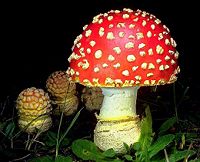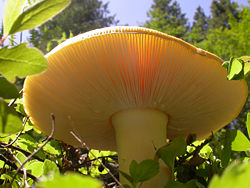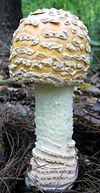Amanita muscaria
For the course duration, the article is closed to outside editing. Of course you can always leave comments on the discussion page. The anticipated date of course completion is May 21, 2009. One month after that date at the latest, this notice shall be removed. Besides, many other Citizendium articles welcome your collaboration! |
| Amanita muscaria | ||||||||||||||
|---|---|---|---|---|---|---|---|---|---|---|---|---|---|---|
 | ||||||||||||||
| Scientific classification | ||||||||||||||
| ||||||||||||||
| Binomial name | ||||||||||||||
| Amanita muscaria (L.) Lam. |
Description and significance
Amanita muscaria, commonly known as the fly agaric, is a psychoactive fungus. Known as the fly agaric for its ability to kill houseflies when combined with milk.[1] The common hallucinogenic compounds found in Amanita muscaria are ibotenic acid (α-amino-3-hydroxy-5-isoxazoleacetic acid) and muscimol (5-(aminomethyl)-3-hydroxyisox-azole).
It is a fairly large mushroom with a bright red cap that ranges from 8-20 cm in diameter. The white spots on the cap are remains of the [universal veil]], a membrane that covers the mushroom at a young age. A partial veil usually forms a skirt like ring on the upper region of the stalk. The stalk or stipe is white or cream in color ranging from 5-20 cm high and 1-2 cm wide. The gills are free or slightly attached and are white in color.[2][3]
Distribution and habitat
The fly agaric mushroom grows in symbiosis with birch, pine, and fir.[4] It can be found in regions of both hemispheres (Alaska, Siberia, Scandinavia, central Europe, North America, Australia, Mexico, the Philippines) and in other regions where the aforementioned trees are located. The fly agaric is also found in the form of fairy rings.[5]
Pharmacology


The two psychoactive agents fount in Amanita Muscaria are Ibotenic acid and Muscimol. Muscarine was originally thought to be the active hallucinogenic ingredient in A. muscaria. It was later found by researchers in the mid 20th century that these effects were caused by Ibotenic acid and Muscimol. There is a much larger amount of Ibotenic acid than Muscimol in the fly agaric, however the Ibotenic acid is decarboxylated when dried out turning it into Muscimol, this provides the psychoactive effect.[6] Other agents found in A. muscaria are Muscarine, Muscazone, Bufotenin (5-OH-DMT), l-hyoscayamine, stizolobinic acid, stizolobic acid, methyltetrahydrocarboline carboxylic acid.[7]
Various species
Amanita muscaria var. formosa, the yellow-orange fly agaric mushroom. It is found in eastern North America, abundant in the Sierra Nevada region.[8]
Amanita muscraia var. flavivolvata, a form of the red fly agaric mushroom. It is found in western North America, common in northern California.[9]
Amanita pantherina, the Panther Amanita. It can be dark to light brown or tan to dull yellow in color. It is common in Pacific Northwest but rare in the East. It has the highest incident of poisoning in the Pacific Northwest due to its confusion with A. gemmata.[10]
Amanita gemmata, the Gemmed Amanita. It is creamy to pale yellow or golden yellow in color. Found primarily on the west coast.[11]
Amanita phalloides, the “Death Cap”. This mushroom is highly poisonous. Varies in color from olive-green, yellow-green to yellow, gray and brown.[12] It can be found in North America and is said to have been imported with European oak trees. It is mycorrhizal with oak trees in the summer and fall. A. phalloides has also been found in Pennsylvania so exact range is unclear.[13]
Symptoms
Anthough the fly agaric is not considered to be deadly, the Ibotenic acid and Muscimol produce a large range of symptoms. These symptoms include nausea, dizziness, euphoria, deep coma-like sleep, hallucinations, headaches, auditory and visual distortions, twitching and mood changes.[14]

